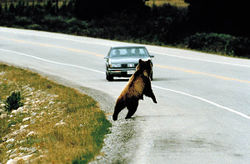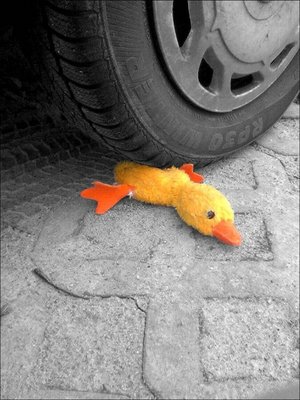Roadkill
“So, vhy did ze chicken cross ze road? Vell, it could have been attempted suicide... ”
– Road kill on Sigmund Freud
Roadkill or Bushmeat (calque from the French viande de brousse) is the term commonly used for the raw meat of terrestrial wild animals, run over for fun or by mistake throughout the humid tropics of the Americas, Asia, and Africa. Wildlife crossings were created to allow animals to travel directly across paved road surfaces, and also because wildlife bridges were too expensive. They are most widely used in Europe, but have also been installed in a few U.S. locations and in parts of Western Canada. As new highways cause habitats to become increasingly fragmented, these crossings could play a crucial role in protecting endangered species (as soon as animals learn what the white lines mean, and how to press the "walk" button.)
Alternatively, roadkill is a high class cuisine enjoyed by pillars of society such as Rednecks, Trailer Trash, Pikeys, Lowlifes, Bankers, and Top Gear Presenters.
History[edit | edit source]
Roadkill dates back to the days of the horseless carriage; unfortunately, the necessity of the newly invented roads were ill-explained to animals. Many theories have arisen as to why some animals became obsessed with crossing roads. Sigmund Freud hypothesized one particular theory in his book Sometimes a Bunny is Just a Pancake. In his highly acclaimed manuscript, Freud explored the tendency of albino Peruvian three-toed prairie lions to stand in the path of large speeding motor vehicles when near the end of their life cycles. It created a precedence in the animal kingdom that spread like wildfire. In response to this, the United Nations passed laws preventing vehicle-assisted suicides among woodland creatures, but to no avail.
In 1945, the American Auto Industry started designing larger vehicles to combat the loss of human life in vehicle/animal accidents. In 1964, the National Brewers Association released a study that concluded drunk drivers were not nearly as dangerous as deer who ran in front of drunk drivers, causing them to swerve into oncoming traffic. Further studies released in the late 1980's found that unsafe road conditions were caused by a lower IQ among road construction crews. They explained how confounded the workmen were by the unexplained presence of animal carcasses on the roadway, so they would just pave over them.
Evolution[edit | edit source]
The evolution of roadkill has progressed greatly in recent years as highway speeds restrictions have been relaxed. This unprecedented combination of natural selection and artificial selection has led to faster animals with armored exoskeletons, as it is a hell of a lot harder to find the sweet spot on the front of a 2010 Corvette traveling at 97 MPH (156.106368 kph). In the 30's, an animal sometimes had to wait ten or twenty minutes to get struck by a Model A Ford that lacked the turning radius to swerve. This has also had its drawbacks in the animal kingdom as some unfortunate species were unable to evolve at a fast enough rate, and were left with finding other ways to commit suicide. Some species such as the Dodo bird simply had to rely on heavy smoking and binge drinking to end their unhappy tenure on Earth.
Uses[edit | edit source]
This form of passive eugenics ultimately led to many serendipitous rewards. The meat of roadkill is now a favored ingredient in cuisine in many Third World nations. This is also true of the Southern United States, where it is a staple to a well balanced diet. In the case of the word "roadkill" as a slang word in modern English, it refers to someone who died by abrupt and spectacular means, such as being unexpectedly squashed by a rolling column of Chinese military tanks. This creates a great spectacle for bored motorists and pursuing paparazzi. Some news outlets will pay thousands of dollars for pictures of a drunken celebrity in some state biological or anatomical disorganization. Hundreds of thousands if you can capture those final blood curdling moments on video. Remember to stay vigilant: your moment could come soon! If its only a dead squirrel, well, if it's still warm it's probably edible (unless it's the middle of winter, then it's just mystery-meat).
Fun Recipe[edit | edit source]
Large animals including deer, moose, bear, and elk are frequently struck in some parts of the United States, as well as smaller animals such as armadillos, raccoons, skunks, frogs, ants, and assorted non-flying birds. Fresh kill is preferred and intestinal parasites are a concern, so the kill is typically well-cooked. Advantages of roadkill diet, apart from its low cost, are that the animals that roadkill scavengers eat are naturally high in vitamins and proteins with lean meat and little saturated fat, and generally free of artificial additives and growth hormones.
Roadkill Stew[edit | edit source]
What you’ll need:
- One pound VelveetaTM cheese
- One can crushed tomatoes and peppers
- One dead skunk OR one live raccoon, a 1997 Buick LeSabre, and a driveway
- ½ cup diced onions
- ½ cup chopped jalapenos (use habenaros if the meat is still crawling (that will kill whatever may still be inside!))
- One teaspoon minced garlic
Directions:
- Cut the VelveetaTM into cubes and add the tomatoes.
- If you choose a live raccoon, now would be an ideal time to run it over with the Buick.
- Vaporize the skunk/raccoon fur and skin off with a blowtorch.
- Leave skunk/raccoon to cool down.
- When they are cool enough, strip off any remaining skin with a steel wool pad.
- Eviscerate the roadkill and split it lengthwise.
- Put all the good roadkill parts in a jar, with the fresh peppers, herbs and oil.
- Leave this for half an hour in direct sunlight.
- Process contents of jar through an industrial meat grinder (feel free to add some not-so-good roadkill parts and a dash of raw anger)
- Shape into a 1 cm thick patty and fry on high heat for 45 minutes, along with the onions, jalapenos, and garlic. Crumble and drain on paper towels.
- Microwave the cheese and tomatoes on high for about one minute. Stir. Return to microwave until completely smooth and melted. Add the remaining ingredients and mix well.
Serves 2.

